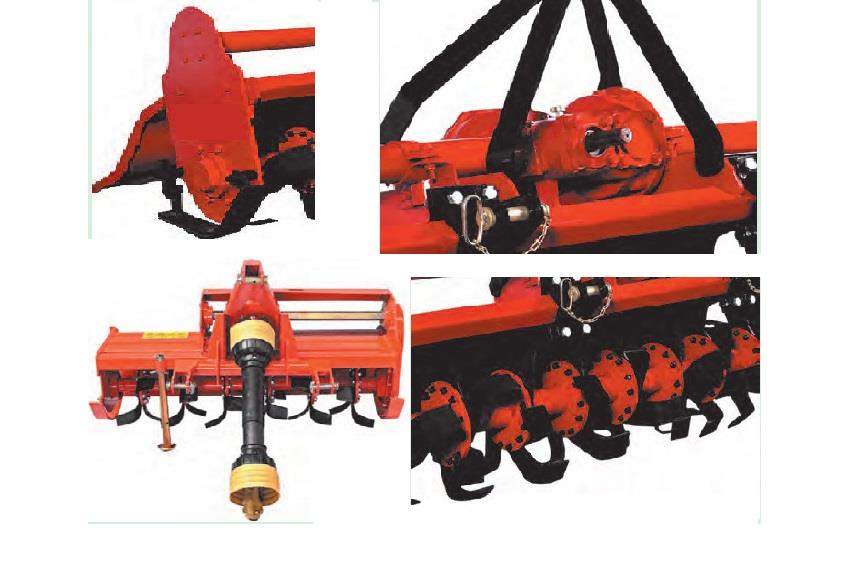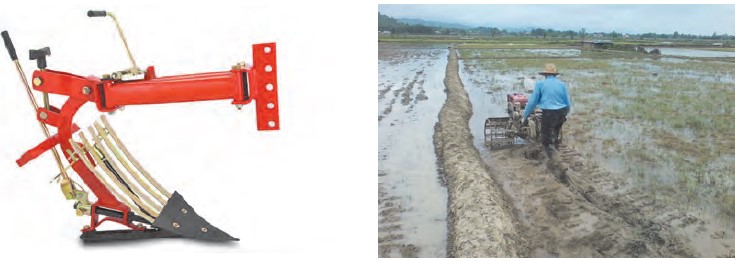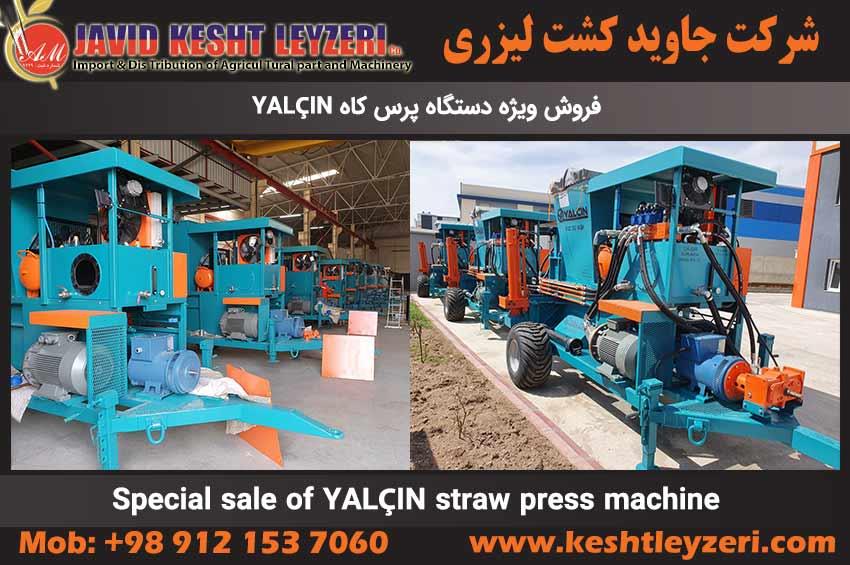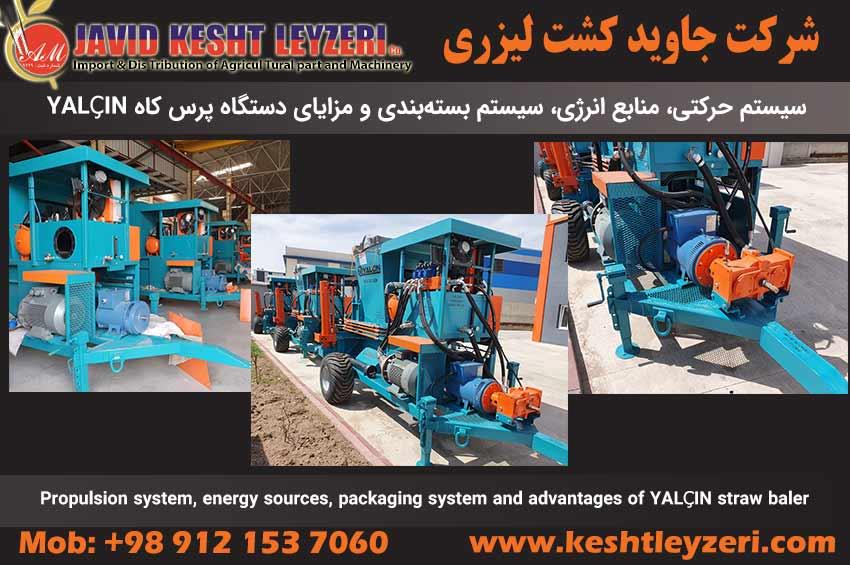
Equipment for Tilling and Cultivating
JAVID KESHT LEYZERI COMPANY
The word “tillage” is used to refer to many types of mechanical operations that move soil to change soil conditions, manage crop residues, manage weeds, or incorporate fertilizers or pesticides. Specific tillage systems may be referred to by the primary tillage implement used such as a plow, rototill, spader, strip till, ripper, etc. Sometimes tillage systems are referred to by their overall objective, such as conventional tillage, conservation tillage, no-till, or reduced tillage. Secondary tillage refers to soil disturbance following primary tillage that is designed to prepare a seed bed or achieve some other specific objective. Cultivation lightly disturbs the soil surface to manage weeds and residues.

Tillage provides a nice seedbed by temporarily decreasing soil compaction. In this “looser” soil, seedlings can grow more easily, air exchange is facilitated, and water penetrates more rapidly. Also, competing plant species are injured or killed by tillage. In annual cropping systems, even in no-till systems, it is necessary to disturb soil to place a transplant or seed. No-till or conservation tillage systems reduce soil disturbance to minimize the negative impacts of tillage.
Timing
Tillage can be destructive to soil quality, especially when it is done at the wrong time. Excessively wet soils are said to be “plastic”; they move and smear easily and can be molded by heavy machinery leading to sub-soil compaction. If deep tire tracks are left in the soil, then the soil is probably too wet for tilling. Implements such as rototillers and spaders will also destroy aggregates and form clods to a greater extent in excessively wet soil.
The proper time to till soils is when they are “friable”, meaning that the physical impact of tillage equipment breaks soil rather than smearing or molding it. Clay content affects the range of soil water content when soils are friable; soils rich in clay become plastic at a lower soil water content than sandier soils and also have a narrower window of water content when soils are friable.
Implements
There are numerous pieces of equipment that can be used to move soil for a particular purpose. For example, the Soil Science Society of America’s Glossary of Soil Science Terms has 118 entries under “Tillage”.
Select pieces of tillage equipment are shown below.
Tractors
Tractors are not essential for every farm. Walk-behind two wheel “tractors” are often sufficient for smaller operations. It is also possible to hire operators and machinery for custom work. However, for many, a tractor opens up new opportunities for mechanizing labor-intensive operations and may allow for increasing scale.
Selecting a Tractor for the Small Farm
OK, you bought the farm, and you have moved onto the property, with excitement, and anticipating new activities in your farming ventures. There are a tremendous number of activities that need to be done on a small farm, regardless of the size. For the new or beginning farmer, one inevitable hurdle to overcome is how you will power your farm activities? You can farm with a number of power sources, such as walk behind small scale 2 wheel type machines, or with tractors, or you can custom hire work that needs to be done. If you decide that having a tractor fits into your operation, read on. This article will be the first in a series of how to select, acquire, operate and maintain smaller scale farm machinery. Often people ask me “What tractor should I buy?”, and “How much does a tractor cost?” As with all things agricultural, the answer is “it depends”. One of the first things that I ask a new farmer is “What do you want and need to do with a tractor, and, how much can you afford to spend?” Each activity mentioned in this article will require certain machines in addition to a tractor and will be addressed in later articles.
This is a an older 65 horsepower tractor that would be a good choice for a new and small farm. All photos by Rich Taber
This is a an older 65 horsepower tractor that would be a good choice for a new and small farm. All photos by Rich Taber
The following is a list of activities which might be occurring on a farm or homestead at any given time of the year and requiring specific tractors and machines:
Brushhogging meadows and pastures for grazing management and to prevent the fields from growing back into forest. This is one of the most critical jobs on a small farm, as nature can be relentless in working to restore forests. If fields are let to grow for more than about three years, small trees and brush will begin to take over, and then can be extremely difficult and expensive to correct.
Haymaking, which might be either small square bales, or large round bales of dry hay or baleage. The process can require mowing, tedding, raking, baling, wrapping high moisture bales, and hauling and unloading hay.
Tillage activities, such as plowing, disking, harrowing, planting, and of course, picking stones.
Planting crops such as forages, row crops such as corn and cereal grains, fruits and vegetables, and possibly food plots for wildlife.
This is a three point hitch implement that is an important tool for mowing brush and pastures.
This is a three point hitch implement that is an important tool for mowing brush and pastures.
Pulling a variety of 2 and 4 wheel wagons around on the farm for diverse activities, such as hauling crops and hay, firewood, and giving hayrides to people.
Harvesting crops other than dry hay, such as chopping high moisture hay for haylage or greenchop, and vegetables.
Front end loader work for snow removal, manure handling, feeding animals, moving materials around the farm, and loading and hauling hay and other crops.
Working in the woods skidding logs, hauling firewood, and hauling maple sap to the sugar house.
I am going to make some assumptions before I begin to suggest which tractor might be a good choice for you. Assumption one: right now, you are going to try to do as many operations as possible on your farm with one tractor, while you’re getting started. As you build equity and experience, you may someday need another tractor or two, because as you will find out, not all tractors are suited to all purposes, but for now, we will focus on getting you this first tractor to do as many things as possible.
Assumption two: you only have a given amount of money to spend, and that you might be looking for a good used tractor. New tractors can be prohibitively expensive; if you can afford one, good for you.
Assumption three: you may be looking for a smaller to medium size tractor to get everything done; leaving the big tractors for those who truly need them.
Live hydraulics and pto (power take off) are important; older tractors made in the forties and fifties frequently did not have “live” features, which meant if you pushed in the tractor’s clutch, the pto or hydraulics stopped working. This can be quite annoying when you are in thick crops and have to use the clutch, and have to start up again from a dead stop.
Now that we have all of these features to think about, I will describe my version of a tractor that if I could only have one tractor, this is the type that I would look for, for my first tractor on a smaller farm.
1. I would want a tractor made in the latter part of the twentieth century, at least from about 1970 onward. Older tractors made after World War II still abound, but lack many of the needed operational and safety features expected today. Narrow front ends from that era were very dangerous and lacked many of the safety features that we expect nowadays. These type of tractors can be very dangerous!
2. I would prefer having a diesel engine; not many farm tractors come with gasoline engines anymore. Older tractors from the sixties and early seventies with gasoline engines can be quite aggravating to keep running smoothly on a year round basis, especially the ones made before the era of electronic ignition.
3. It is mandatory to have a three point hitch. So much farm equipment exists which requires this feature making it an absolute requirement. Often you can purchase aftermarket three point hitch assemblies for older tractors but they tend to be expensive, awkward to use, and not very efficient.
4. I would prefer two sets of live hydraulic outlets (this is required to run many farm machines today). If your tractor has only one set of hydraulic hoses, a second set can be added if and when your machinery needs dictate.
5. A front end loader (often the front end loader ties up one set of hydraulic outlets leaving you only one other set to operate equipment).
6. Not too many hours on the hour meter, preferably under 5,000 hours. Repairs and overhauls can be extremely expensive!
7. If not a fully enclosed cab, at least a Roll Over Protective Structure (ROPS) should be mandatory, with a seat belt. A canopy is a nice addition on top of the ROPS. The ROPS is for roll over protection and can save lives, and the canopy can prevent you from baking in the sun during those hot summer days, and will keep some rain off of you.
This 52 horsepower tractor has a front end loader attached to it, useful for handling many kinds of materials.
This 52 horsepower tractor has a front end loader attached to it, useful for handling many kinds of materials.
8. It would be nice to have four wheel drive; our long snowy winters and muddy rainy summer months, especially if the tractor has a front end loader, make you able to get into a lot of places you normally would not, and you can easily get stuck. There are two basic types of tractor operators, those who have been stuck, and those who are going to get stuck. Getting stuck and having to have the neighbors come pull you out frequently can strain neighborly relations.
9. Live power take off. Some older obsolete tractors have “non-live” pto which makes controlling the actions of your equipment awkward and difficult.
10. How much horse power? There are different ways to describe h.p. but for right now we can simply say that a tractor with between about 45 to 75 horsepower should fit our needs.
11. How much will this tractor cost? Depending on the age, condition, and features present, you can expect to pay at least $5,000 up to $20,000 for a good used tractor such as I have described in this article. In general, the more features, the more costly the machine will be.







